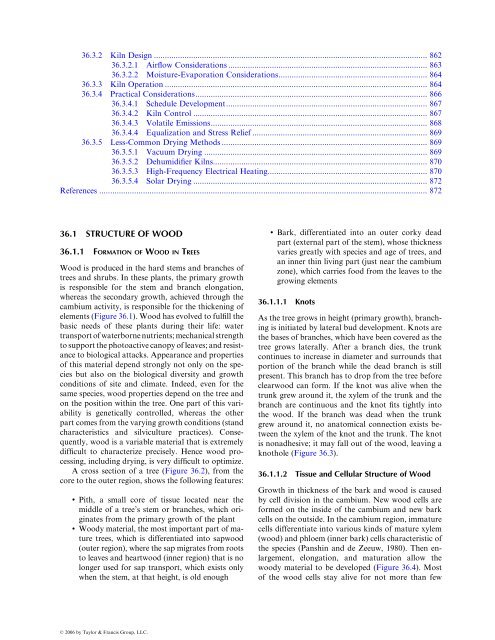36 Drying of Wood
36 Drying of Wood
36 Drying of Wood
- No tags were found...
You also want an ePaper? Increase the reach of your titles
YUMPU automatically turns print PDFs into web optimized ePapers that Google loves.
<strong>36</strong>.3.2 Kiln Design ............................................................................................................................. 862<strong>36</strong>.3.2.1 Airflow Considerations........................................................................................... 863<strong>36</strong>.3.2.2 Moisture-Evaporation Considerations.................................................................... 864<strong>36</strong>.3.3 Kiln Operation........................................................................................................................ 864<strong>36</strong>.3.4 Practical Considerations.......................................................................................................... 866<strong>36</strong>.3.4.1 Schedule Development............................................................................................ 867<strong>36</strong>.3.4.2 Kiln Control ........................................................................................................... 867<strong>36</strong>.3.4.3 Volatile Emissions................................................................................................... 868<strong>36</strong>.3.4.4 Equalization and Stress Relief................................................................................ 869<strong>36</strong>.3.5 Less-Common <strong>Drying</strong> Methods.............................................................................................. 869<strong>36</strong>.3.5.1 Vacuum <strong>Drying</strong> ...................................................................................................... 869<strong>36</strong>.3.5.2 Dehumidifier Kilns.................................................................................................. 870<strong>36</strong>.3.5.3 High-Frequency Electrical Heating......................................................................... 870<strong>36</strong>.3.5.4 Solar <strong>Drying</strong> ........................................................................................................... 872References ...................................................................................................................................................... 872<strong>36</strong>.1 STRUCTURE OF WOOD<strong>36</strong>.1.1 FORMATION OF WOOD IN T REES<strong>Wood</strong> is produced in the hard stems and branches <strong>of</strong>trees and shrubs. In these plants, the primary growthis responsible for the stem and branch elongation,whereas the secondary growth, achieved through thecambium activity, is responsible for the thickening <strong>of</strong>elements (Figure <strong>36</strong>.1). <strong>Wood</strong> has evolved to fulfill thebasic needs <strong>of</strong> these plants during their life: watertransport<strong>of</strong>waterbornenutrients;mechanicalstrengthtosupportthephotoactivecanopy<strong>of</strong>leaves;andresistanceto biological attacks. Appearance and properties<strong>of</strong> this material depend strongly not only on the speciesbut also on the biological diversity and growthconditions <strong>of</strong> site and climate. Indeed, even for thesame species, wood properties depend on the tree andon the position within the tree. One part <strong>of</strong> this variabilityis genetically controlled, whereas the otherpart comes from the varying growth conditions (standcharacteristics and silviculture practices). Consequently,wood is a variable material that is extremelydifficult to characterize precisely. Hence wood processing,including drying, is very difficult to optimize.A cross section <strong>of</strong> a tree (Figure <strong>36</strong>.2), from thecore to the outer region, shows the following features:. Pith, a small core <strong>of</strong> tissue located near themiddle <strong>of</strong> a tree’s stem or branches, which originatesfrom the primary growth <strong>of</strong> the plant. <strong>Wood</strong>y material, the most important part <strong>of</strong> maturetrees, which is differentiated into sapwood(outer region), where the sap migrates from rootsto leaves and heartwood (inner region) that is nolonger used for sap transport, which exists onlywhen the stem, at that height, is old enough. Bark, differentiated into an outer corky deadpart (external part <strong>of</strong> the stem), whose thicknessvaries greatly with species and age <strong>of</strong> trees, andan inner thin living part (just near the cambiumzone), which carries food from the leaves to thegrowing elements<strong>36</strong>.1.1 .1 Knot sAs the tree grows in height (primary growth), branchingis initiated by lateral bud development. Knots arethe bases <strong>of</strong> branches, which have been covered as thetree grows laterally. After a branch dies, the trunkcontinues to increase in diameter and surrounds thatportion <strong>of</strong> the branch while the dead branch is stillpresent. This branch has to drop from the tree beforeclearwood can form. If the knot was alive when thetrunk grew around it, the xylem <strong>of</strong> the trunk and thebranch are continuous and the knot fits tightly intothe wood. If the branch was dead when the trunkgrew around it, no anatomical connection exists betweenthe xylem <strong>of</strong> the knot and the trunk. The knotis nonadhesive; it may fall out <strong>of</strong> the wood, leaving aknothole (Figure <strong>36</strong>.3).<strong>36</strong>.1.1 .2 Tiss ue and Cellu lar Structure <strong>of</strong> Woo dGrowth in thickness <strong>of</strong> the bark and wood is causedby cell division in the cambium. New wood cells areformed on the inside <strong>of</strong> the cambium and new barkcells on the outside. In the cambium region, immaturecells differentiate into various kinds <strong>of</strong> mature xylem(wood) and phloem (inner bark) cells characteristic <strong>of</strong>the species (Panshin and de Zeeuw, 1980). Then enlargement,elongation, and maturation allow thewoody material to be developed (Figure <strong>36</strong>.4). Most<strong>of</strong> the wood cells stay alive for not more than fewß 2006 by Taylor & Francis Group, LLC.
















